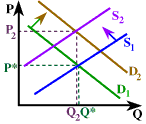

Copyright © 1995-2005 OnLineTexts.com, Inc. - All Rights Reserved
 9. Naturally, wool is an important ingredient in the production of wool sweaters. If the price of wool increases, the supply of wool sweaters will shift back (decrease). At the same time, if fashion designers are showing a lot of wool sweaters in their fall shows, the demand for wool sweaters will increase, shifting demand out.
9. Naturally, wool is an important ingredient in the production of wool sweaters. If the price of wool increases, the supply of wool sweaters will shift back (decrease). At the same time, if fashion designers are showing a lot of wool sweaters in their fall shows, the demand for wool sweaters will increase, shifting demand out.
When both supply and demand shift, we know that we can only predict the direction of the change in price or the quantity, not both. Since both a shift back in supply causes the price to rise, and a shift out in demand causes the price to rise, we can confidently predict that the price of wool sweaters will increase. However, a shift back in supply causes the quantity to fall, and a shift out in demand causes the quantity to rise. Since these two work in opposite directions, we can't predict the direction of change in quantity. We show a tiny drop in the graph to the right, but the change could go either way.
The result of these combined shifts will be that price will rise unambiguously, but quantity is indeterminate, as in (e). Let's briefly examine the other choices.

